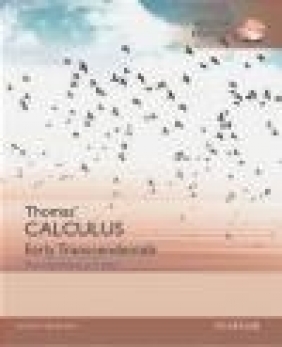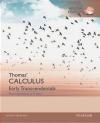Thomas' Calculus: Early Transcendentals in Si Units
Joel Hass, Maurice Weir, George Thomas
Thomas' Calculus: Early Transcendentals in Si Units
Joel Hass, Maurice Weir, George Thomas
- Wydawnictwo: Pearson
- Rok wydania: 2016
- ISBN: 9781292163444
- Ilość stron: 1200
- Oprawa: Miękka
Niedostępna
Opis: Thomas' Calculus: Early Transcendentals in Si Units - Joel Hass, Maurice Weir, George Thomas
This text is designed for a three-semester or four-quarter calculus course (math, engineering, and science majors). Thomas' Calculus: Early Transcendentals, Thirteenth Edition, introduces students to the intrinsic beauty of calculus and the power of its applications. For more than half a century, this text has been revered for its clear and precise explanations, thoughtfully chosen examples, superior figures, and time-tested exercise sets. With this new edition, the exercises were refined, updated, and expanded-always with the goal of developing technical competence while furthering students' appreciation of the subject. Co-authors Hass and Weir have made it their passion to improve the text in keeping with the shifts in both the preparation and ambitions of today's students. The text is available with a robust MyMathLab(R) course-an online homework, tutorial, and study solution. In addition to interactive multimedia features like lecture videos and eBook, nearly 9,000 algorithmic exercises are available for students to get the practice they need. Please note that the product you are purchasing does not include access to MyMathLab(R). Students, if MyMathLab is a recommended/mandatory component of the course, please ask your instructor for the correct ISBN and course ID. Instructors can contact their Pearson representative for more information.1 Functions 1.1 Functions and Their Graphs 1.2 Combining Functions; Shifting and Scaling Graphs 1.3 Trigonometric Functions 1.4 Graphing with Software 1.5 Exponential Functions 1.6 Inverse Functions and Logarithms 2 Limits and Continuity 2.1 Rates of Change and Tangents to Curves 2.2 Limit of a Function and Limit Laws 2.3 The Precise Definition of a Limit 2.4 One-Sided Limits 2.5 Continuity 2.6 Limits Involving Infinity; Asymptotes of Graphs 3 Derivatives 3.1 Tangents and the Derivative at a Point 3.2 The Derivative as a Function 3.3 Differentiation Rules 3.4 The Derivative as a Rate of Change 3.5 Derivatives of Trigonometric Functions 3.6 The Chain Rule 3.7 Implicit Differentiation 3.8 Derivatives of Inverse Functions and Logarithms 3.9 Inverse Trigonometric Functions 3.10 Related Rates 3.11 Linearization and Differentials 4 Applications of Derivatives 4.1 Extreme Values of Functions 4.2 The Mean Value Theorem 4.3 Monotonic Functions and the First Derivative Test 4.4 Concavity and Curve Sketching 4.5 Indeterminate Forms and L'Hopital's Rule 4.6 Applied Optimization 4.7 Newton's Method 4.8 Antiderivatives 5 Integrals 5.1 Area and Estimating with Finite Sums 5.2 Sigma Notation and Limits of Finite Sums 5.3 The Definite Integral 5.4 The Fundamental Theorem of Calculus 5.5 Indefinite Integrals and the Substitution Method 5.6 Definite Integral Substitutions and the Area Between Curves 6 Applications of Definite Integrals 6.1 Volumes Using Cross-Sections 6.2 Volumes Using Cylindrical Shells 6.3 Arc Length 6.4 Areas of Surfaces of Revolution 6.5 Work and Fluid Forces 6.6 Moments and Centers of Mass 7 Integrals and Transcendental Functions 7.1 The Logarithm Defined as an Integral 7.2 Exponential Change and Separable Differential Equations 7.3 Hyperbolic Functions 7.4 Relative Rates of Growth 8 Techniques of Integration 8.1 Using Basic Integration Formulas 8.2 Integration by Parts 8.3 Trigonometric Integrals 8.4 Trigonometric Substitutions 8.5 Integration of Rational Functions by Partial Fractions 8.6 Integral Tables and Computer Algebra Systems 8.7 Numerical Integration 8.8 Improper Integrals 8.9 Probability 9 First-Order Differential Equations 9.1 Solutions, Slope Fields, and Euler's Method 9.2 First-Order Linear Equations 9.3 Applications 9.4 Graphical Solutions of Autonomous Equations 9.5 Systems of Equations and Phase Planes 10 Infinite Sequences and Series 10.1 Sequences 10.2 Infinite Series 10.3 The Integral Test 10.4 Comparison Tests 10.5 Absolute Convergence; The Ratio and Root Tests 10.6 Alternating Series and Conditional Convergence 10.7 Power Series 10.8 Taylor and Maclaurin Series 10.9 Convergence of Taylor Series 10.10 The Binomial Series and Applications of Taylor Series 11 Parametric Equations and Polar Coordinates 11.1 Parametrizations of Plane Curves 11.2 Calculus with Parametric Curves 11.3 Polar Coordinates 11.4 Graphing Polar Coordinate Equations 11.5 Areas and Lengths in Polar Coordinates 11.6 Conic Sections 11.7 Conics in Polar Coordinates 12 Vectors and the Geometry of Space 12.1 Three-Dimensional Coordinate Systems 12.2 Vectors 12.3 The Dot Product 12.4 The Cross Product 12.5 Lines and Planes in Space 12.6 Cylinders and Quadric Surfaces 13 Vector-Valued Functions and Motion in Space 13.1 Curves in Space and Their Tangents 13.2 Integrals of Vector Functions; Projectile Motion 13.3 Arc Length in Space 13.4 Curvature and Normal Vectors of a Curve 13.5 Tangential and Normal Components of Acceleration 13.6 Velocity and Acceleration in Polar Coordinates 14 Partial Derivatives 14.1 Functions of Several Variables 14.2 Limits and Continuity in Higher Dimensions 14.3 Partial Derivatives 14.4 The Chain Rule 14.5 Directional Derivatives and Gradient Vectors 14.6 Tangent Planes and Differentials 14.7 Extreme Values and Saddle Points 14.8 Lagrange Multipliers 14.9 Taylor's Formula for Two Variables 14.10 Partial Derivatives with Constrained Variables 15 Multiple Integrals 15.1 Double and Iterated Integrals over Rectangles 15.2 Double Integrals over General Regions 15.3 Area by Double Integration 15.4 Double Integrals in Polar Form 15.5 Triple Integrals in Rectangular Coordinates 15.6 Moments and Centers of Mass 15.7 Triple Integrals in Cylindrical and Spherical Coordinates 15.8 Substitutions in Multiple Integrals 16 Integrals and Vector Fields 16.1 Line Integrals 16.2 Vector Fields and Line Integrals: Work, Circulation, and Flux 16.3 Path Independence, Conservative Fields, and Potential Functions 16.4 Green's Theorem in the Plane 16.5 Surfaces and Area 16.6 Surface Integrals 16.7 Stokes' Theorem 16.8 The Divergence Theorem and a Unified Theory 17 Second-Order Differential Equations online 17.1 Second-Order Linear Equations 17.2 Nonhomogeneous Linear Equations 17.3 Applications 17.4 Euler Equations 17.5 Power Series Solutions Appendices A.1 Real Numbers and the Real Line A.2 Mathematical Induction A.3 Lines, Circles, and Parabolas A.4 Proofs of Limit Theorems A.5 Commonly Occurring Limits A.6 Theory of the Real Numbers A.7 Complex Numbers A.8 The Distributive Law for Vector Cross Products A.9 The Mixed Derivative Theorem and the Increment Theorem
Producent:
GPSR Pearson Central Europe Sp. z o.o.
ul. Szamocka 8
01-748 Warszawa (PL)
tel: 459 596 060
email: [email protected]
Szczegóły: Thomas' Calculus: Early Transcendentals in Si Units - Joel Hass, Maurice Weir, George Thomas
Tytuł: Thomas' Calculus: Early Transcendentals in Si Units
Autor: Joel Hass, Maurice Weir, George Thomas
Wydawnictwo: Pearson
ISBN: 9781292163444
Rok wydania: 2016
Ilość stron: 1200
Oprawa: Miękka
Waga: 1 kg




















